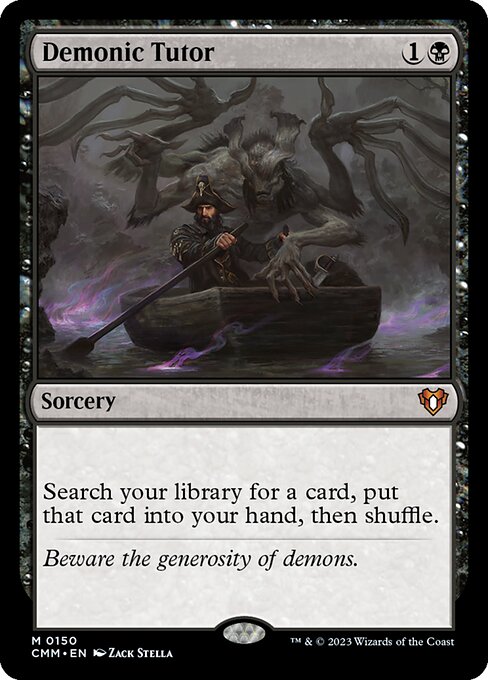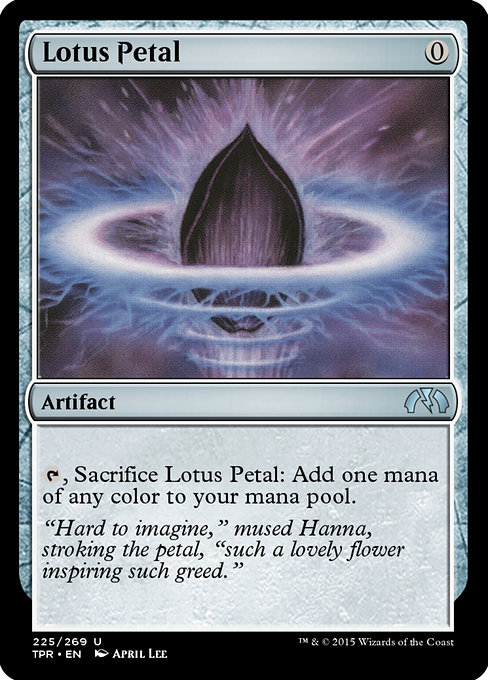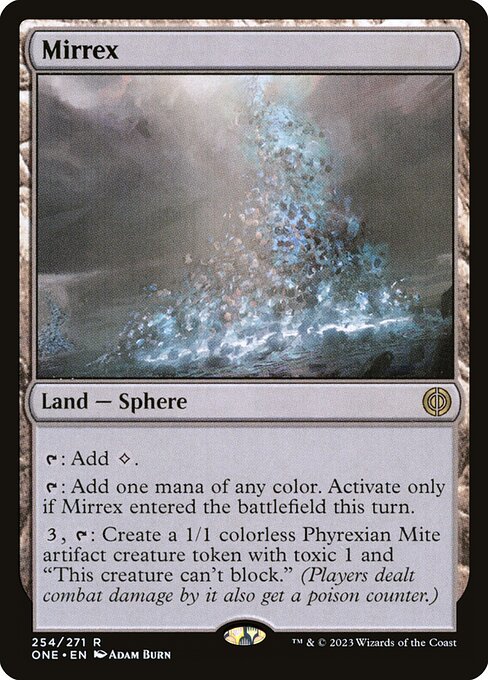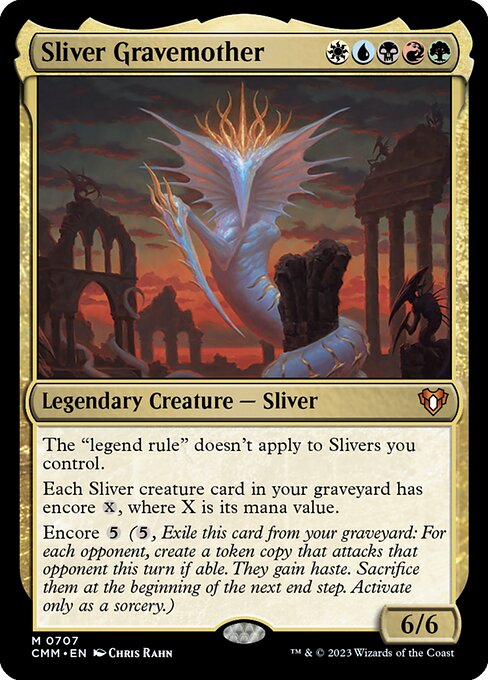(Note: all prices derived from MTGStocks.com, whose historical data is dependable and comprehensive. We’re talking mostly about trends, so I’ve made estimates where reasonable.)
The trajectory of card prices is usually predictable–the vast majority of cards drop from their preorder prices upon a set’s release and hit an initial peak supply on the weekend of a release, then hit their absolute bottom about six months after the release of a set. But not every card follows this pattern–Invasion of Gobakhan was a two-dollar preorder before it started seeing play and Orcish Bowmasters has doubled its initial price point–but generally speaking, the best time to buy cards is either the week after the set comes out or six months following a release.
There are exceptions, which is how we, as outsiders to Wizards’ sales numbers, can track how a set is performing. The big hits of Commander Masters, for example, had a different trajectory than the usual downtrend. The weekend the set came out, prices dropped, as they did for Double Masters–foil borderless Urza for $9-10, Deadly Rollick at $10-12, borderless Demonic Tutor for $36.00. But, unexpectedly, prices started to quickly rebound. Checking MTGStocks for heavy hitters yields a very predictable pattern: a dip on Friday-Saturday, followed by a retracing over subsequent weeks. By contrast, last summer’s Double Masters 2022 was a race-to-the-bottom bloodbath, with five dollar Aether Vials galore and Surgical Extraction falling off a cliff from $18-20 a copy to $3.

For a contrasting–and expected–outcome, compare the set to Wilds of Eldraine–the Restless lands are heading towards a dollar, Ashiok, Wicked Manipulator can be snagged for $4 or so, and most of the value appears tied up in the Enchanting Tales bonus sheet. That’s all to be expected–Evolved Sleeper started at over $10 and can now be picked up for a tenth of that, Elesh Norn/The Argent Etchings preordered for over forty and can now be picked up for under ten, etc. Standard doesn’t drive prices the way it did pre-pandemic, and even if it did, powerful cards from Neon Dynasty and The Brothers’ War are poised to overshadow the relatively conservative designs of Eldraine. Beseech the Mirror is absurd, of course–a Diabolic Tutor that lets you turn incidental Food tokens or Prismatic Prisms into Blacker Lotus–but the set, overall, seems closer to the Strixhaven side of the power continuum.
Magic finance–loosely defined as the speculative practice of identifying undervalued cards and letting them mature before selling for a profit–is in an interesting space in 2023. The crypto- and CARES Act-fueled pandemic days are in the rearview, and speculation has settled down from the feverish peak of 2020-2021. Wizards’ commitment to printing Secret Lairs and promotional cards means even tournament staples and Commander icons are likely targets for consistent reprintings. The constant churn of new sets means a new class of expensive staples arises every few months, and the old practice of “buy low, let copies filter out of the market, then pounce when prices are high” is hard to time correctly. Gone are the days when you could grind through a bulk box for cards that were gathering buzz–the age of social media and smart phones has given even the most lax store owner immediate awareness of cards that are spiking–and probably fictitious were the days of finding dual-laden boxes of cards at yard sales and $1 Tempest packs at the flea market.

But there are still deals out there, and more importantly, there’s a decade-plus of data we have access to in the age of the algorithm that helps us predict what will spike and when to purchase cards at their lows. We have three decades of player spending habits, metagame developments, and Wizard reprint strategies to go off of–while these are in flux, particularly in the age of Secret Lairs and Universes Beyond, Commander drives long-term prices and tournament formats drive short-term prices. Subtlety bottomed out at five dollars last winter as the also-ran of the pitch Elemental cycle, but, much as even Frost Titan once spiked, an eventual spike was inevitable–it’s a Blue card that can be played for free, after all. Fury and Grief were also once briefly attainable for five and ten dollars, respectively, before becoming Modern staples. In June of 2021, $80 would have bought you one Ragavan, Nimble Pilferer or sixteen copies of Fury; now, they’re basically one-to-one. I don’t expect to see that kind of exponential spike anytime soon, but there are cards in the ceaseless tide of recent sets that are on my radar for future growth.
To generalize, our best targets belong to these classes:
- Single-printing cards from unpopular releases. Lorwyn/Shadowmoor rares, for example, spiked heavily following the Commander boom, and popular cards from unpopular Secret Lairs command extremely high prices. Buying a ton of the breakfast cereal Secret Lair at $30 a pop didn’t seem like a solid investment, but when you can sell the Ulamog, the Ceaseless Hunger for $40 a copy, buying a time-limited, one-time (so far) printing is an easy pick. The less popular a set, the better the eventual returns–meaning that March of the Machine: Aftermath is a good place to start from a purely financial perspective.
- Commander-exclusive cards. The print runs of Commander decks aren’t published, but we can see from past spikes–Clever Concealment, Bennie Bracks, Zoologist, Forth Eorlingas!–how quickly copies can leave the market. Preconstructed Commander decks are often bought by casual players who may not even take the deck apart and who definitely aren’t fully aware of the game’s economic superstructure. Their cards may never leave their deckboxes, which means they never enter the market. Two-Headed Hellkite, Nesting Dovehawk, Glistening Sphere–these cards are designed to be attractive to Commander players and scarce in the marketplace, meaning they’re primed to spike. Not every Commander exclusive is a winner, but the ones that hit, hit hard.
- Popular creature types. If it does something unique, I’m interested. If it does something unique and is a Human, Angel, Demon, Dragon, Sliver, Elf, Goblin, Rat, Rogue, Zombie, Merfolk, Cat, Dog, Ninja, Dinosaur, Knight, or Eldrazi, I’m in. Of those, Eldrazi and Slivers are (as Commander Masters suggests) huge casual/Commander types, and the overlap between casual interest and tournament demand in Human, Zombie, Elf, Elemental, and Goblin cards make those very easy speculative picks. Buying the Eldrazi precon at $100+ is bad finance; buying $100 worth of Rise of the Eldrazi and Flayer of Loyalties is a much better option.
With that on the table, here’s where I’m parking my disposable income:
Mithril Coat

Mithril Coat is my eat-your-vegetables, Commander-driven lock for a safe speculative pick. Colorless Equipment that protects your creatures is a rock-solid investment, and the mana value isn’t a huge ask to leave open. Compare the price of the Coat to its closest analogue, Darksteel Plate. Darksteel Plate was first printed in 2011’s Mirrodin Besieged, and steadily rose in price from 2011-2018, before halving in price after a reprint in Duel Decks: Elves vs. Inventors. It spiked once those copies had filtered out of the market, peaking at $20 before a reprint in Double Masters 2022 brought it back down below ten dollars–temporarily, as it’s showing growth since.
Mithril Coat has the same mana value, but costs one more to Equip, so it’s not a strict upgrade. That said, the ability to Flash it in and snap it automatically onto your Commander for free is a huge benefit. Right now, Mithril Coat hovers around $7.50–I expect it to be going for $20 in two years’ time.
While we’re on the subject of Duel Decks: Elves vs. Inventors, note that set’s printing of Goblin Welder, which was the first non-Judge foil printing since the vanishingly rare Urza’s Legacy version. For a solid two years, you could get as many copies as you wanted for about a dollar–now, those same copies go for $12-13 a piece. A Tarmogoyf from the same time period would have cost you $70-75 and is now worth $13–one Welder bought at a dollar would now be approximately a fair trade one-to-one. That’s the sort of trajectory any Magic finance geek dreams of and the sort we’re looking for in recent sets.
Much of Tales of Middle-Earth is holding value exceptionally well–my impression, based on the stability of card prices and the speed at which bundles vanish from big box store shelves, is that the cards are being concentrated in the hands of casual players, outside of the usual churn of trade-ins. The major retailers are consistently sold out of the more desirable cards, and there are more desirable cards in the set than the norm. I can’t really recommend stocking up until we see the size of the winter print run and what the Tales of Middle-Earth second run contains, but my targets for eventual pickup are Spiteful Banditry, Call of the Ring, Elven Chorus, and the various Equipment. Nazgul will be in high demand for years, but, until we know Wizard’s full plan for the set and for future printings, I can’t recommend buying in–as a Rat Colony/Shadowborn Apostle variant, any deck that wants one wants nine, but the buy-in is too high at the moment.
Mirrex

Mirrex–Toxic has been a bust as a competitive strategy. Some Toxic cards have shown up in high-level play, but Skrelv seems the only one with staying power, and that predominantly as a Mother of Rune instead of a Glistener Elf. It seemed for a moment that Skrelv’s Hive was going to be a worthy successor to Bitterblossom–instead, an unlikely card outshone it. Mirrex is a single-shot Glimmervoid with the bonus of spitting out attackers for three mana (four, including tapping Mirrex itself). It’s a control finisher, a casual Infect component, and a land-based token producer–it may take a while to creep up, but like the tokens it produces, it’s inevitable.
Brothers’ War Meld Cards

The Brothers’ War meld cards–particularly Mishra, Claimed by Gix, who can be snagged for $5-6. Mishra, Urza, Titania, and their rare counterparts are huge, relatively cheap, and hard to reprint–a great spot to be in for future growth. The abundance of cheap Brothers’ War booster boxes–and lack of truly desirable cards–means these may fall even further. None of them are easy to flip in play, but their lore resonance and the seductive potential of their melded forms will make them attractive to casual players for years to come, so they’ll be easy to flip in the marketplace. Mishra may be the best value, but Urza, Lord Protector is a cost-reducer who is one of Magic’s most important characters and has the most room to grow. Titania is less story-relevant, but she’s relatively easy to flip in Commander and consistently exciting for players unfamiliar with Meld cards. You’re not just trying to predict what’s playable, but what’s cool–it’s an exercise in marketing, not just in tournament prognostication.
Rare Slivers from Commander Masters

The Rare Slivers from Commander Masters–How many Sliver Commander decks do you think were purchased at the $80-100 price point? How many of those do you expect to be broken down for parts instead of kept together in the deckboxes of countless Sliver players? Lazotep Sliver, Capricious Sliver[mtg_card], [mtg_card]Regal Sliver, Taunting Sliver, and Hatchery Sliver are all under five bucks and apt to go the way of all Slivers. Sliver Gravemother is also in contention here, but she’s a more costly buy-in. The rare Slivers, though, can slot into any Sliver deck from here through the end of the game, and are about the cost of a Standard booster pack. Stashing away a small stack of these single-print Slivers and getting out before they become multi-print Slivers can subsidize your future Magic purchases.
Quick Hits from Eldraine
Quick hits from Eldraine–Creature-lands often perform better than they read (c.f. Shambling Vent), and I’ve been very impressed with Restless Cottage and Restless Bivouac as ways to give aggro decks reach in Standard. Blossoming Tortoise could be a plant for Ixalan, or could just slowly accrue value in the manner of Ashaya, Soul of the World or Avenger of Zendikar. Virtue of Loyalty is the front half of Invasion of Belenon with the back half of Invasion of Gobakhan and Knights aren’t going to go unsupported anytime soon. The lack of rotation hurts Eldraine–Lord Skitter is obsolesced by Graveyard Trespasser and Were-Fox Bodyguard is outshone by Brutal Cathar and Virtue of Persistence is basically worse than Breach the Multiverse, for example–but Commander decks are always looking for redundant effects and a mana base that does more than just tap to cast spells.
All gains are temporary. Wizards of the Coast knows which cards are popular with players and which command a high price due to scarcity and desirability and those cards are shortlisted for reprinting. Like any form of gambling, the best thing you can do is know when to get out. Sheoldred, the Apocalypse headlined Dominaria United and will, no doubt, see a reprint in 2025 in a Secret Lair or Masters set. Going deep on Sheoldreds at $70 in the hopes that she won’t see a reprint but will continue seeing consistent play is a fool’s wager when that same $70 could buy you eleven copies of Mishra, Claimed by Gix–a card that doesn’t see consistent tournament play, but is a) unique and splashy and b) low-priority on the reprint list for logistical reasons. Even if you don’t want to speculate, it’s worth paying attention to what’s rising and falling–if a card has hit a plateau week-over-week, now’s the time to buy and reduce what you’ll have to pay in months to come.
Above all else, if a card does something unique, even if it doesn’t see a second of play in Standard, buy heavy. Emrakul, the Promised End bottomed out at about $8 back in 2018; now, copies sell for ten times that. Orvar, the All-Form was under two dollars for four months and now sells for $15. That’s still a gamble–my stack of five dollar Kaldra Compleats has lost half its value thanks to recent reprints, for example–but cards with creative abilities rarely sink to bulk and often spike to multiple times their initial worth. Above all else, remember: always keep a stash of cards that can be cast for free (Once Upon a Time, Snuff Out, Force of Negation), always pick up anything with “Mox” in the name (yes, even Mox Tantalite), and never underestimate people’s love of Rats and Slivers. Lord Skitter may be overshadowed by Graveyard Trespasser during his tenure in Standard and may never hit over a dollar while thousands of packs of Eldraine are being drafted and busted for the Beseech the Mirror lottery, but his reign will be long in Thrumming Rats Commander decks. Ashiok, Wicked Manipulator is a standard “card advantage, minor protection, situational game-winner” Planeswalker, but that tempting static ability may make them spike from four dollars now to forty in 2029 with some combo piece. Scalding Viper may be a pallid facsimile of Eidolon of the Great Revel, but worse cards have seen tournament play–and quadruple in price for one giddy weekend. You can’t predict what will spike or what will collapse upon a reprinting–or six–but you can read patterns and be a savvy collector.
Rob Bockman (he/him) is a native of South Carolina who has been playing Magic: the Gathering since Tempest block. A writer of fiction and stage plays, he loves the emergent comedy of Magic and the drama of high-level play. He’s been a Golgari player since before that had a name and is never happier than when he’s able to say “Overgrown Tomb into Thoughtseize,” no matter the format.

